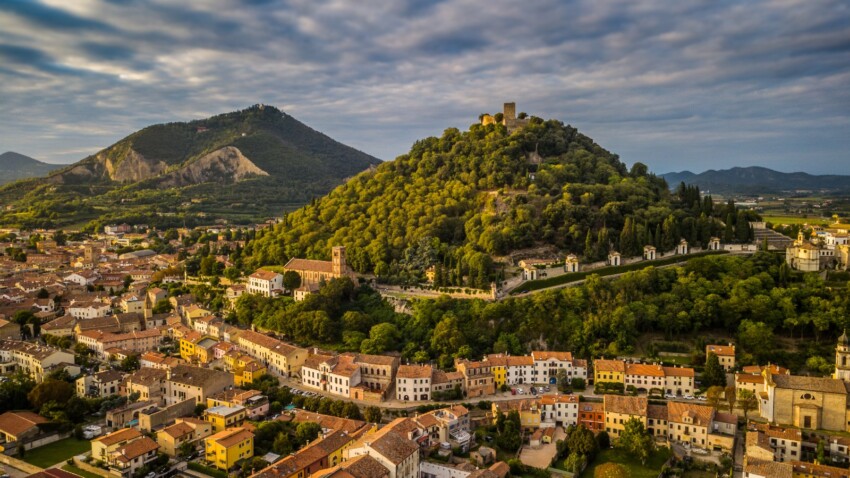

A short distance from the world-famous cities of art, Italy’s largest lake and the Dolomite mountain range is a lesser-known but no less fascinating Veneto: that of the historic villages.
Of ancient origins, often dating back thousands and thousands of years, many of them became important centres as early as Roman times, but it was the Middle Ages that forged their appearance as we admire it today. And it is also this era that has bequeathed us the walls that have protected the most beautiful villages in the Veneto from raids and destruction over the centuries.
How fortunate! Thanks to the imposing fortifications built by the lords and squires of the past, the walled towns of Veneto have retained their charm intact and can present themselves to today’s tourists as ideal destinations for an unforgettable day trip or a slow-paced weekend break.
Some are now lively towns, full of clubs and shops, others are sleepy villages, perfect for leaving behind the hustle and bustle of the city, immersing oneself in relaxation and being moved by poetic suggestions. Some villages stand proudly atop the gentle slopes of the Veneto hills, others are scattered across the wide expanse of the Po Valley.
Where to find them? A bit all over the region, actually, but if you want to go for a sure shot, bet on the 10 most beautiful walled cities in Veneto that we have selected for you.
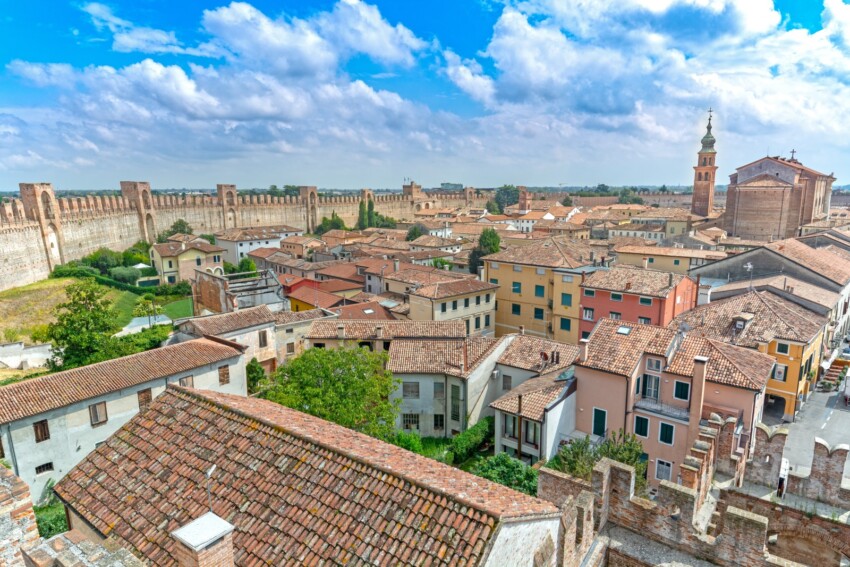
When speaking of walled towns in the Veneto, the first name that comes to mind is Cittadella, a town in the upper Po valley whose historical centre is enclosed within a perfectly preserved elliptical wall. Four gates open along the walls (Porta Bassano, Porta Vicenza, Porta Padova, Porta Treviso).
The special feature of the Cittadella walls is that they are entirely walkable on foot. The wall patrol walkway can be visited for a fee, and the ticket also includes admission to the town museums (Casa del Capitano and Torre di Malta). A guided tour is possible on request.
The height of the walkway, about 15 metres above the ground, does not allow for wide panoramic views, but this does not detract from the charm of your historical walk.
You will be able to see the historical centre of Cittadella from above, with the two main streets intersecting in perfect harmony; outside the centre you will be able to see the Euganean Hills to the south and Monte Grappa to the north. You can also enter the interior of the Tower of Malta, used as a prison at the time of Ezzelino da Romano and now a museum, and access the 30-metre-high panoramic terrace.
The walls of Cittadella are not only a fascinating monument to visit, but also the suggestive location of numerous open-air events.
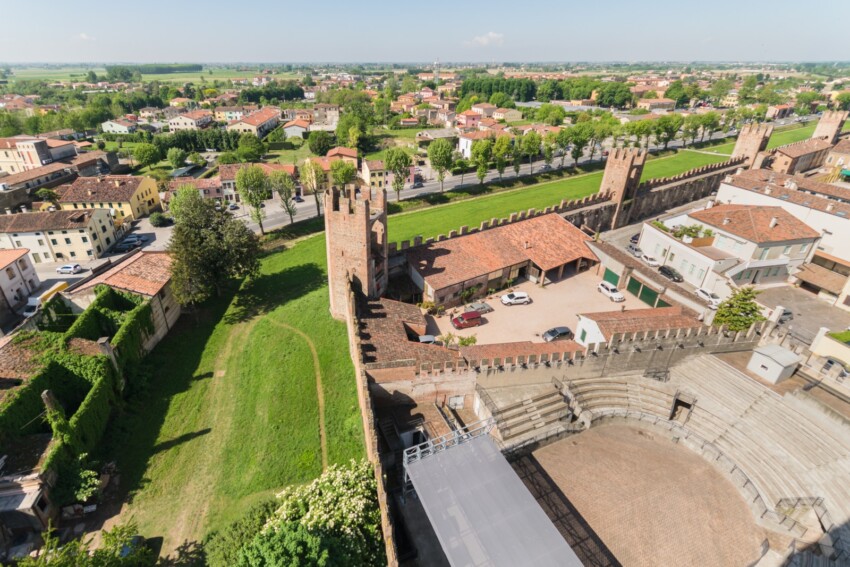
Another Veneto town that has made the walls its pride is Montagnana, a village in the province of Padua almost equidistant from Padua, Vicenza and Verona. The historical centre is enclosed within a perfectly preserved city wall, 2 km long and reinforced by 24 hexagonal crenellated towers; four gates open along the walls.
An initial fortification was built as early as the early Middle Ages, but those we admire today date back to the 13th century and were built by Ezzelino III da Romano, known as the Tyrant; they were later extended in the 14th century. The best side to admire the walls of Montagnana in their majesty is the north-east side, from where you can see the gap between the 13th-century and 14th-century walls.
If you want to get your fill of the medieval atmosphere, visit Montagnana during the days of the Palio dei 10 Comuni, an important historical commemoration held between August and September.
Entering the centre you can admire the Castle of San Zeno and splendid palaces from the Renaissance period, but the real top attraction of Montagnana after the walls is the sweet raw ham, a local delicacy not to be missed.
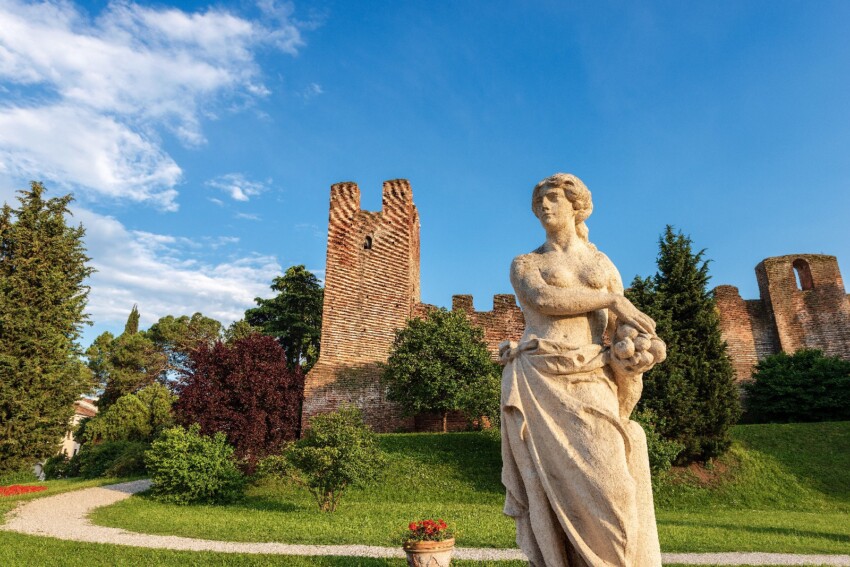
On a single day you can combine a visit to Cittadella with another important walled city that is less than 15 km away but falls within the province of Treviso. This is Castelfranco Veneto, an elegant and dynamic town located in a strategic point for connections between Treviso, Padua and Vicenza.
The urban layout of the centre of Castelfranco is clearly mediaeval: the historical heart of the city, enclosed within walls dating back to the 12th century, has a quadrilateral shape and is crossed by two perpendicular arteries. The four corners of the quadrilateral are marked by as many towers and the walls are still surrounded by a moat.
The city is famous for being the birthplace of Giorgione, one of the most important Venetian painters of the 15th century. His most important works are kept in museums in Venice; however, inside the cathedral of Castelfranco you can see a famous altarpiece depicting the Madonna and Child Enthroned and Saints Francis and Liberal and works by other important artists such as Veronese and Jacopo Bassano.
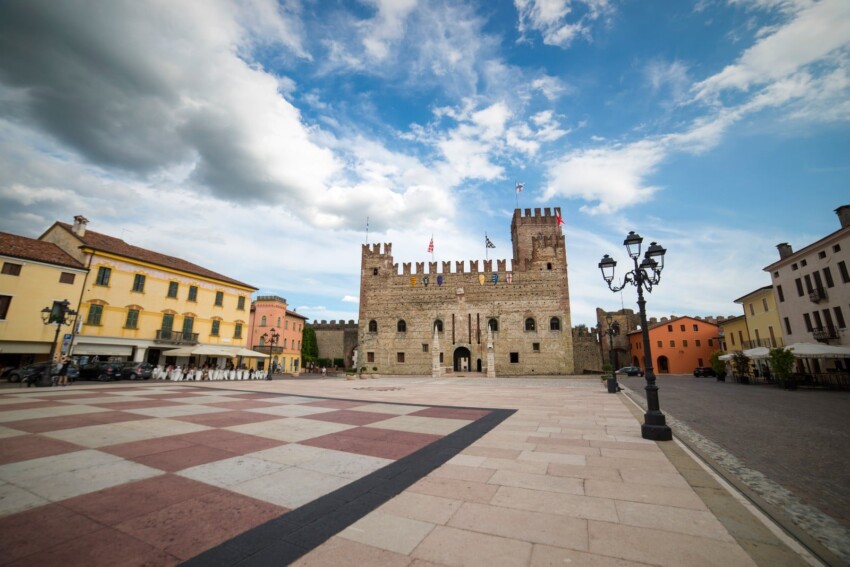
If you speak of the Queen of Chess in Veneto, no one will think of a TV series: the thought immediately goes to Marostica, the walled city where the most famous living chess game in Italy is held every year.
The scenic chessboard where this popular game is played (staged by more than 600 costumed figures) is in the centre of the magnificent Piazza Castello.
The square is enclosed on three sides by porticoed palaces and on the fourth side by the Lower Castle, while behind it rises a green hill dominated by the Upper Castle; the two castles are connected by an imposing city wall.
If you visit Marostica outside the match days, you can admire some of the original costumes in the Chess Museum housed inside the Lower Castle or photograph the chessboard from above from the castle’s patrol path.
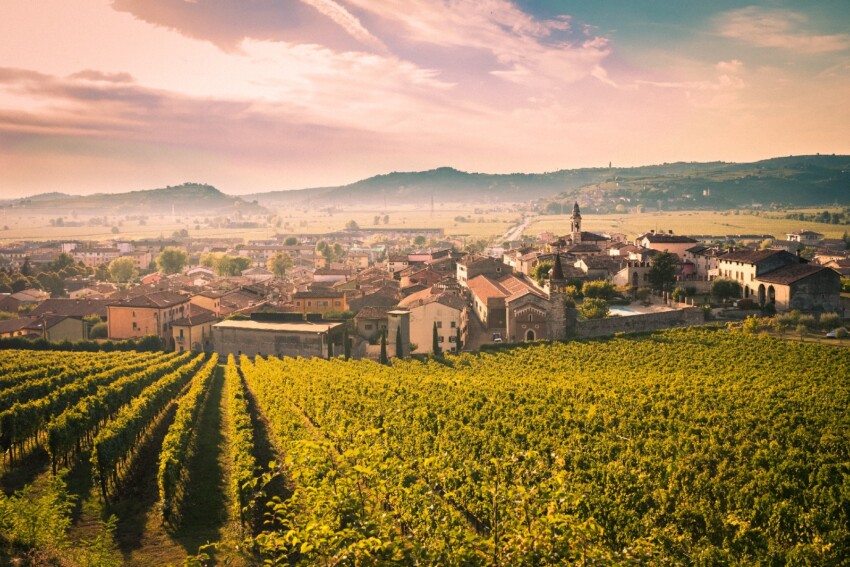
One of the most beautiful castles in Veneto is that of Soave, a delightful medieval village in the province of Verona.
Perched on Monte Tenda, the castle of Soave is a medieval fortress with an imposing wall that descends along the slopes of the hill embracing the historic centre of the village. Soave’s walls were built in the 14th century, some three centuries after the original core of the castle was constructed. Access to the town is through four gates.
Soave is also known as one of the most important wine production areas in the Veneto region. There are no less than four DOC and DOCG wines in the area and together they represent a considerable slice of wine production in the province of Verona. You can taste them in the town’s wine shops or in the wine cellars of the surrounding area.

The walled city of Monselice is one of the most important centres of the Euganean Hills, the characteristic cone-shaped hills of volcanic origin that rise south of Padua.
The symbol of the town is the Rocca, a hillock behind the centre dominated by an imposing keep built at the behest of Emperor Frederick II of Swabia.
The first part of the route to reach the top of the Rocca di Monselice is marked by seven votive chapels known as the Santuario Giubilare delle Sette Chiese (Seven Churches’ Jubilee Sanctuary) and ends next to the 16th-century Villa Duodo. The final flight of steps starts from here.
If after walking up and down the Rocca you still feel like walking, you can turn your gaze to the opposite side of the centre of Monselice. Mount Ricco, its paths immersed in greenery and its panoramic terraces await you.
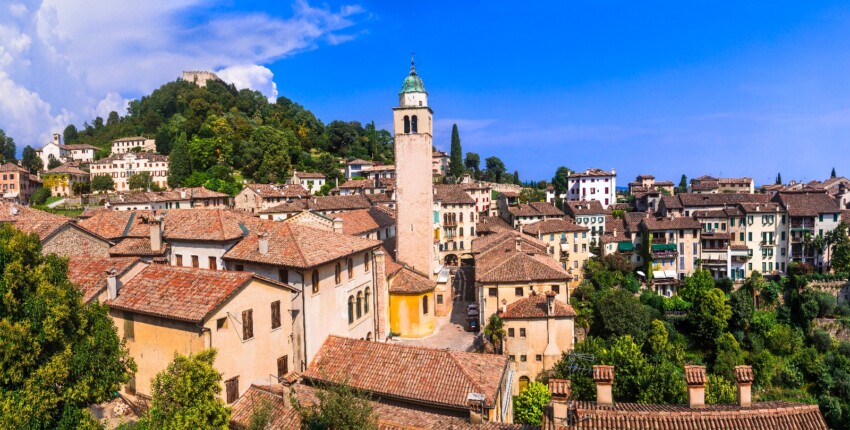
Enchanting views and literary suggestions make Asolo one of the most romantic walled towns in the Veneto region.
Due to its fortunate position on the Pedemontana Trevigiana, the hilly strip that stretches between the flat expanse of the Po Valley and the mountains of the Belluno Pre-Alps, it was beloved by writers and artists of different eras.
Giosuè Carducci coined for Asolo the appellative ‘City of a Hundred Horizons’ while we owe to the English poet Browning the expression ‘asolando’, or walking around contemplating beauty. Three women with strong temperaments chose this pretty hill town as their eternal home: the traveller Freya Stark, Queen Catherine and the divine actress Eleonora Duse, known as the Three Ladies of Asolo.
Asolo is also a destination not to be missed for those who want to do food and wine tourism in the Veneto: the Asolo hills are in fact an important wine production area, famous for Prosecco.
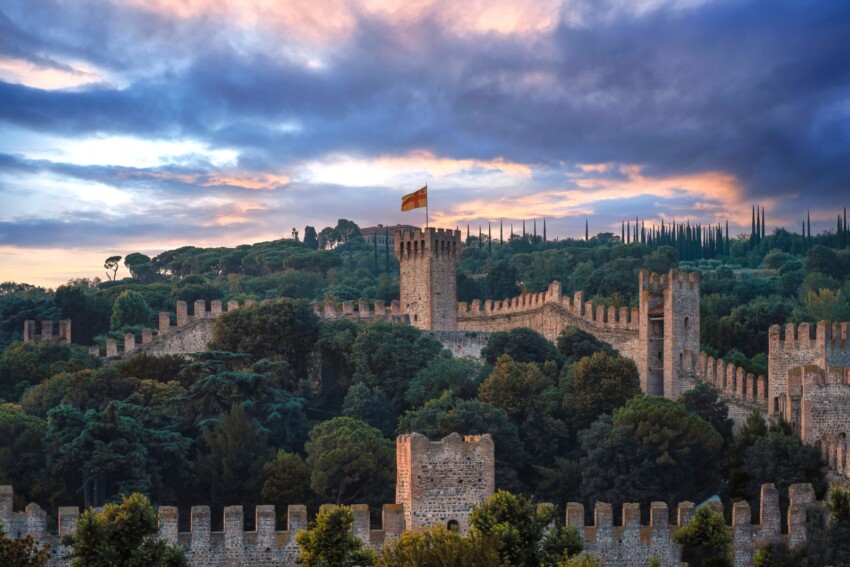
The walls of Este enclose the worldly salon of the Euganean Hills: a lively city, with a centre always bustling with people intent on shopping or enjoying an aperitif.
Este is an elegant city rich in history. It has early Venetian origins, but its appearance is typically medieval: the walls date back to the 14th century and were built by the Carraresi of Padua; they originally had 14 crenellated towers, of which 12 are preserved today.
The symbolic monument is the Carrarese Castle, but during your walk through the centre you can admire other interesting historical buildings. If you are interested in history, a visit to the Atestino National Museum is also recommended.
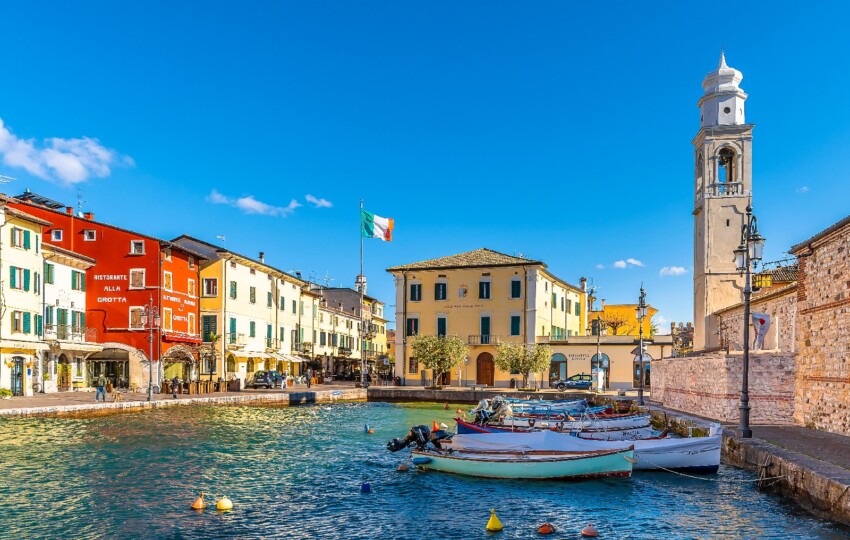
One of the most famous resorts along the Venetian shore of Lake Garda is Lazise, a town that can boast of being the first Free Commune of Italy, declared such as early as 983. In order to maintain this independence, it soon equipped itself with walls to protect the magnificent Scaliger Castle, which today is the symbol of the town.
Despite the many modifications it has undergone over the centuries, the castle of Lazise has kept intact the austere appearance typical of medieval fortresses; its position on the lakeshore, however, makes it evocative and unique. The castle cannot be visited, but it is possible to walk along the walls.
There is another famous castle with a medieval appearance around Lazise, but the construction is very recent (dating back to the last century). We are talking about the castle of Gardaland, Italy’s number one amusement park: an unmissable destination for a day of family fun.
If, on the other hand, you want to treat yourself to a spa weekend on Lake Garda, you can combine a visit to Lazise with a day at the Terme di Colà.
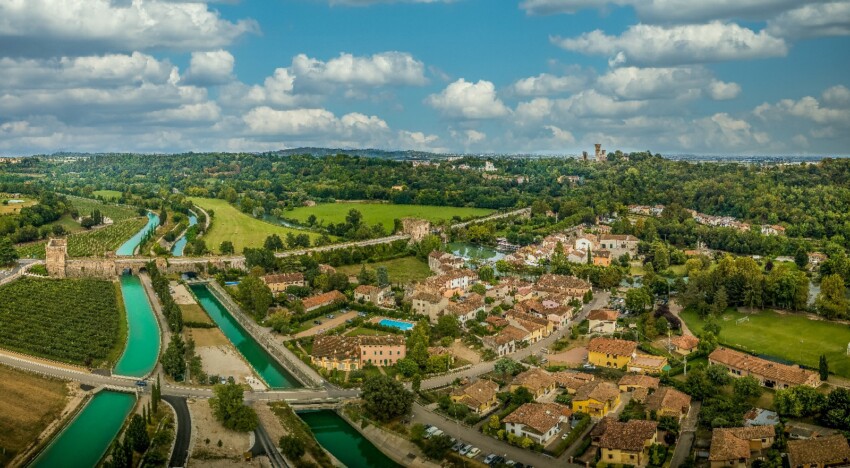
Another walled town on the Veneto shore of Lake Garda that is worth a visit is Valeggio sul Mincio, one of the most picturesque places on the entire lake.
The town comprises four hamlets, of which the best known and most visited is Borghetto: a handful of houses gathered along the Mincio river among which are hidden romantic spots just waiting to be photographed. The symbol of Borghetto are the watermills, many of which have now been converted into charming restaurants and B&Bs.
The best vantage point over the village is the Ponte Visconteo, or Ponte Lungo, a fortified dam that joins the two banks of the river.
You will (reluctantly, we are sure!) have to leave Borghetto to admire the Castello Scaligero di Valeggio sul Mincio, a defensive fortress perched on a hill next to the historic centre. From the tower of the Rocca you can enjoy a beautiful panoramic view of the town and the surrounding countryside.
An attraction not to be missed in Valeggio sul Mincio is the Parco Giardino Sigurtà, a huge botanical garden that has been landscaped down to the last detail. It can be reached on foot from the historical centre.
In the following map you can see the location of the main places of interest mentioned in this article.